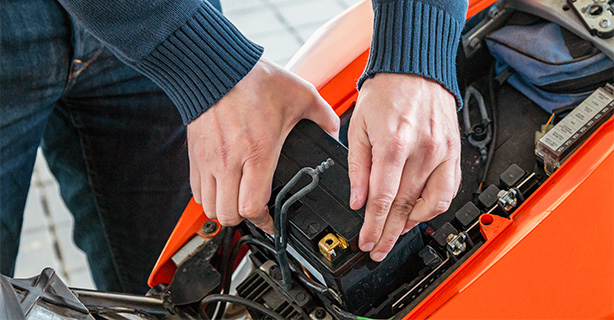A quality motorcycle ride depends on a good battery
0 min. read
Motorcycles rely on a good battery for starting the engine, powering the lights and stereo, as well as energizing the electric riding gear. Modern motorcycle batteries are so dependable that few riders even think about them until the day when their motorcycle won't start. It's understandable, because motorcycle batteries are relatively small, very dependable, and usually hidden away behind bodywork or under seats where they're easy to forget. Knowing what kinds of battery are out there will help you choose what's right for your bike by being an informed customer.
Standard lead acid batteries
The technology behind modern lead acid batteries dates back to 1859, when the French physicist Gaston Planté invented the first rechargeable battery. It works based on the electrochemical reaction between lead and sulfuric acid. The lead is contained in plates, several of which make up a cell that produces about two volts. There are six cells in a 12-volt motorcycle battery. The plates are suspended in a solution of water and sulfuric acid called an electrolyte.
When current is drawn from the battery, the acid in the electrolyte reacts and bonds with the lead and leaves behind the water. During charging, the reaction is reversed, and acid is returned to the electrolyte solution. Charging causes some of the water molecules to break down to hydrogen and oxygen gases. This gas production is why standard batteries have a vent tube. That escaping hydrogen and oxygen is highly flammable and is the reason for warnings about avoiding sparks and open flames around charging batteries. Some water is lost in the process. That's why these batteries have filler caps for as-needed replenishment of electrolyte solution.
Gel cell or sealed (maintenance-free batteries)
These batteries work on the same basic electrochemical principles—except the gases are captured and reused. In the 1930s it was discovered that by adding silica to the electrolyte, it forms a gel that covers the plates. This allowed gel cell batteries to be used in varying positions without leaking.
A type of sealed batteries are called Valve Regulated Lead Acid batteries (VRLA). Under normal charging, the gases are fully retained and reused, hence the “maintenance-free” claim. If overcharging creates an excessive pressure, a valve vents the gases.
AGM batteries
AGM stands for Absorbed Glass Mat. This type of battery technology began in the 1970s. Very fine glass fibers are woven together to form mats that hold the electrolyte solution against the lead plates. The glass fibers don't actually absorb or react with the electrolyte; they just form a matrix that suspends the solution. These are type of VRLA batteries. The only maintenance they need is cleaning the exterior and terminals.
Lithium-ion and the future
Lithium-ion batteries are making inroads into the powersport battery marketplace. You likely use this type of battery every day in your portable electronic devices. They're lighter than lead acid batteries and cost much more. As these batteries continue to develop, they'll likely be in the electric motorcycles of the future.
By knowing the kinds of batteries out there, you're now ready to make an informed decision when it's time to get a new one.
Till next time, ride safe!
The general information in this blog is for informational or entertainment purposes only. View our blog disclaimer.
*Data accuracy is subject to this article's publication date.







